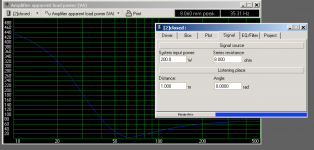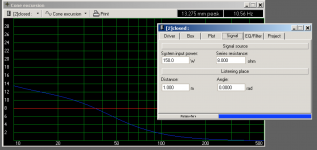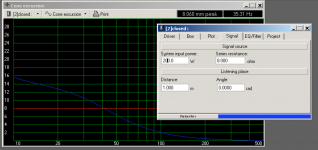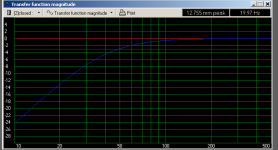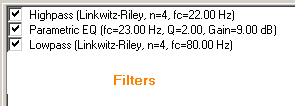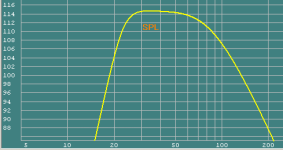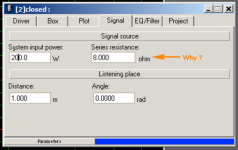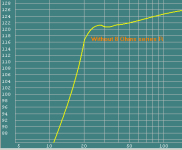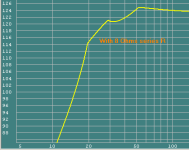Hi all,
I have spent the last few days designing a closed box sub woofer around a Precision Devices 184C01 which will become available soon. I modeled this driver in WinISD was able to get some good looking cone excursion graphs in a box between 100-150 liters. I then played around with the Linkwitz transform function in power point. However, when I apply the Linkwitz transform filter in WinISD I run into some problems. With an input power of 200w the the driver exceeds Xmax at 45Hz and Xlim at 20Hz.
So this is the first sub I am building but my understanding is that I should not be exceeding Xlim as distortion will increase significantly and when the driver exceeds Xmax I will damage the driver. I am not sure if I am doing something wrong here or if these results indicate that I would basically be able to drive this sub with a 50w amp???
I have spent the last few days designing a closed box sub woofer around a Precision Devices 184C01 which will become available soon. I modeled this driver in WinISD was able to get some good looking cone excursion graphs in a box between 100-150 liters. I then played around with the Linkwitz transform function in power point. However, when I apply the Linkwitz transform filter in WinISD I run into some problems. With an input power of 200w the the driver exceeds Xmax at 45Hz and Xlim at 20Hz.
So this is the first sub I am building but my understanding is that I should not be exceeding Xlim as distortion will increase significantly and when the driver exceeds Xmax I will damage the driver. I am not sure if I am doing something wrong here or if these results indicate that I would basically be able to drive this sub with a 50w amp???
The Linkwitz Transform is an equalization scheme only.
Once you put Driver X in Box X you've defined all the maximum SPL capabilities and power requirements of that combination. The Linkwitz Transform equalization scheme will do nothing to improve those aspects.....it only serves to extend the system response over a wider frequency range.
Does that make sense?
Dave.
Once you put Driver X in Box X you've defined all the maximum SPL capabilities and power requirements of that combination. The Linkwitz Transform equalization scheme will do nothing to improve those aspects.....it only serves to extend the system response over a wider frequency range.
Does that make sense?
Dave.
What Davey said. A LT increases lf extension, but not available excursion (which must rise as frequency falls to give the same acoustic output). So there's the tradeoff . . . to get greater extension (at the low end) you have to give up maximum output over the entire passband of the sub. It's easily visualized in WinISD simply by opening two "projects", one with a LT and one without, and looking at the superimposed graphs as you adjust "signal" to avoid overexcursion.
Ported enclosures avoid this (to some extent) because the port becomes the primary radiator at low frequency, and there is no "xmax" to a moving column of air (apart from the eventual chuffing).
Ported enclosures avoid this (to some extent) because the port becomes the primary radiator at low frequency, and there is no "xmax" to a moving column of air (apart from the eventual chuffing).
Yes, that makes perfect sense but applying Linkwitz Transform equalization must result in more cone excursion right?
No, not really...but it depends upon how you look at it.
Look at this excellent section of SL's website regarding the Thor design. (Take note of the last paragraphs at the bottom.)
Electrical and mechanical limits
Cheers,
Dave.
Last edited:
I think Xlim is the damage limiting value.
Is it about double the Xmax value?
The transform gives extra gain at low frequency.
This extra gain results in extra stroke compared to what would happen with out the EQ.
If you have 1W at MF and 1W at LF the speaker will not stroke excessively.
Now apply a +12dB EQ for the transform.
The 1W @ MF stays the same but the LF becomes 15.8W
if the driver can accept 15.8W @ 20Hz and at 30Hz and at ..... then no problem.
Now increase the signal by 10dB so that the MF becomes 10W and the LF becomes 158W.
Does the speaker or the amplifier run out of capability?
Increase the signal by another 6dB (+16dB ref that 1W I started with).
MF power is now 40W, can the MF frequency pass through the amp? Will it damage the speaker?
Consider the LF. The +16dB signal with 12dB of EQ has become 634W. Can the amplifier pass this? Can the driver survive this?
Is it about double the Xmax value?
The transform gives extra gain at low frequency.
This extra gain results in extra stroke compared to what would happen with out the EQ.
If you have 1W at MF and 1W at LF the speaker will not stroke excessively.
Now apply a +12dB EQ for the transform.
The 1W @ MF stays the same but the LF becomes 15.8W
if the driver can accept 15.8W @ 20Hz and at 30Hz and at ..... then no problem.
Now increase the signal by 10dB so that the MF becomes 10W and the LF becomes 158W.
Does the speaker or the amplifier run out of capability?
Increase the signal by another 6dB (+16dB ref that 1W I started with).
MF power is now 40W, can the MF frequency pass through the amp? Will it damage the speaker?
Consider the LF. The +16dB signal with 12dB of EQ has become 634W. Can the amplifier pass this? Can the driver survive this?
Last edited:
Ok guys thanks for all the replies. It will take me a little time to wrap my head around all this info. But basically from what I understand now is that this all revolves around a compromise between the amount of power my amp can deliver and cone excursion.
In this case I Xmax is 8mm and Xlim 15mm and I was planning on using a bridged MiniDSP ICE125 plate amp for this project which puts out 450W into 4 ohms so a little over 200 into my 8 ohm driver. When I modeled the LT in Excel I made sure not to exceed 10db of gain but I may have to lower this.
In this case I Xmax is 8mm and Xlim 15mm and I was planning on using a bridged MiniDSP ICE125 plate amp for this project which puts out 450W into 4 ohms so a little over 200 into my 8 ohm driver. When I modeled the LT in Excel I made sure not to exceed 10db of gain but I may have to lower this.
Not quite. The "compromise" is between LF extension and maximum (broadband) SPL. Xmax determines how loud it can play at any given frequency:what I understand now is that this all revolves around a compromise between the amount of power my amp can deliver and cone excursion.
Piston Excursion calculator
Once you decide how low you want it to go (extension) you have established how loud it can be used at any frequency (while keeping relatively flat response). The LT simply lets you get that flat response . . .
Unless you're playing with tubes amplifier power is rarely if ever the limiting factor (although thermal power handling of the driver may be). You never need more amplifier power than will drive to xmax at the worst case frequency.
Attachments
WinISD's power input is nominal. Linkwitz Transforms throw in a load of boost at LF, so while it might be 100w @ 100Hz as you entered, it might go >1kW at 40Hz due to the boosted response. You can check with the "Amplifier Apparent Power (VA)" tab in WinISD, and correct for it by checking the EQ transfer function and applying static gain to reduce the gain to zero, putting a cut in the higher frequencies. That way, the amount of power you type in is how much you're putting in at the bottom end.
For any given sealed box, the displacement-bound maximum SPL is fixed. If you can move a 18" cone 10mm at 30Hz, you'll get a fixed SPL. What changes with box size is how efficient the sealed box is. A tiny sealed box holds the cone still, reducing efficiency. Very very large boxes provide almost no restoring force, so its pretty well free to move as it likes.
So, a tiny box might need 1kW to get that 10mm excursion, but an infinite baffle setup might need 100w.
Short-term SPL will be identical in both situations. However, there are down-sides to throwing all that power around. The driver's motor will be going non-linear, and you'll be hitting power compression if continuous high-power LF is your thing. Of course, you're using a much smaller box, which is nice.
HTH
Chris
For any given sealed box, the displacement-bound maximum SPL is fixed. If you can move a 18" cone 10mm at 30Hz, you'll get a fixed SPL. What changes with box size is how efficient the sealed box is. A tiny sealed box holds the cone still, reducing efficiency. Very very large boxes provide almost no restoring force, so its pretty well free to move as it likes.
So, a tiny box might need 1kW to get that 10mm excursion, but an infinite baffle setup might need 100w.
Short-term SPL will be identical in both situations. However, there are down-sides to throwing all that power around. The driver's motor will be going non-linear, and you'll be hitting power compression if continuous high-power LF is your thing. Of course, you're using a much smaller box, which is nice.
HTH
Chris
Hi Chris,
Thanks, that really helps. I'm going to play around with WinISD a bit more tonight and see what I come up with. Right now my box is modded at 100l in volume. I quite like that size; after the internal bracing and thick side walls are added it will still be a reasonable size. However, I am aiming for excellent sound quality so if that means increasing the box size and having to throw around less power I'm ok with that. Of course I could also use a different driver with a higher Xmax but from what I've read Precision Devices make some of the best for this application.
BTW, I'm sure many of you are familiar with it but this was my inspiration for this project
Thanks, that really helps. I'm going to play around with WinISD a bit more tonight and see what I come up with. Right now my box is modded at 100l in volume. I quite like that size; after the internal bracing and thick side walls are added it will still be a reasonable size. However, I am aiming for excellent sound quality so if that means increasing the box size and having to throw around less power I'm ok with that. Of course I could also use a different driver with a higher Xmax but from what I've read Precision Devices make some of the best for this application.
BTW, I'm sure many of you are familiar with it but this was my inspiration for this project
After looking at the apparent load graph this is all starting to make a lot more sense to me.
I have included a graph of apparent load of 200w at nominal power for the 100l box. It looks like I would need to increase box size significantly though (to about 250-300l) before getting a significant improvement in efficiency. To me it looks like the ICE125 module should be just about enough to power this driver but it may be worth upgrading to the ICE250 to give me some overhead.
I have also attached a cone excursion graph for 200w and 150w. I think I should be safe as long as I cut off frequencies below 20Hz. If nominal power is kept below 150w the driver can go to 35Hz without exceeding Xmax.
I have also included the transfer function. Let me know what you think
I have included a graph of apparent load of 200w at nominal power for the 100l box. It looks like I would need to increase box size significantly though (to about 250-300l) before getting a significant improvement in efficiency. To me it looks like the ICE125 module should be just about enough to power this driver but it may be worth upgrading to the ICE250 to give me some overhead.
I have also attached a cone excursion graph for 200w and 150w. I think I should be safe as long as I cut off frequencies below 20Hz. If nominal power is kept below 150w the driver can go to 35Hz without exceeding Xmax.
I have also included the transfer function. Let me know what you think
Attachments
Last edited:
Chris brought up some great points. Also something to keep in mind is the xmax is going to limit the SPL of the lower frequencies even if you have ample power and LT boost for the size of the box. Your driver has an Sd area of 1164cm2, that's 15.16 inches of piston diameter. That means with 8mm xmax, you can have a max SPL at 20Hz of 96.5dB at 1 meter. At 10Hz that goes down to 84.4dB.
Whereas a driver like this: HT18 18″ Subwoofer | Stereo Integrity with a piston size of 15.25in, and 22.5mm xmax, you can have a max SPL at 20Hz of 105.5dB at 1 meter. At 10Hz that goes down to 93.5dB.
Yes, this driver is 10dB less efficient but power is cheap these days. The advantage of going sealed with an LT is that you can extend to lower frequencies than a ported sub so I figure when using this system, the lower you can extend the subwoofer's bandwidth at the highest SPL, the better.
Whereas a driver like this: HT18 18″ Subwoofer | Stereo Integrity with a piston size of 15.25in, and 22.5mm xmax, you can have a max SPL at 20Hz of 105.5dB at 1 meter. At 10Hz that goes down to 93.5dB.
Yes, this driver is 10dB less efficient but power is cheap these days. The advantage of going sealed with an LT is that you can extend to lower frequencies than a ported sub so I figure when using this system, the lower you can extend the subwoofer's bandwidth at the highest SPL, the better.
After looking at the apparent load graph
. . .
I have also included the transfer function. Let me know what you think
Neither matter much . . . the graphs which tell all are SPL and Cone Excursion.
Looking at those while adjusting the signal and equalization parameters is where you will find understanding. For use as a subwoofer you will see much better results with that driver in a ported box (but it will be big).
@ jasper9395
Hi, what made you choose that driver ?
Why have you input 8 Ohms series resistance ? I guess it's a mistake.
You haven't mentioned a required LPF for the sub !
If you "must" use this driver, & in a box no bigger than 150L, i would design it as a Bass Reflex, see my screenies
Hi, what made you choose that driver ?
Why have you input 8 Ohms series resistance ? I guess it's a mistake.
You haven't mentioned a required LPF for the sub !
If you "must" use this driver, & in a box no bigger than 150L, i would design it as a Bass Reflex, see my screenies
Attachments
Whereas a driver like this: HT18 18″ Subwoofer | Stereo Integrity with a piston size of 15.25in, and 22.5mm xmax, you can have a max SPL at 20Hz of 105.5dB at 1 meter. At 10Hz that goes down to 93.5dB.
Yes, this driver is 10dB less efficient but power is cheap these days. The advantage of going sealed with an LT is that you can extend to lower frequencies than a ported sub so I figure when using this system, the lower you can extend the subwoofer's bandwidth at the highest SPL, the better.[/QUOTE]
So I took a look at the Dayton Audio UM18-22 which I can get here in the UK. Its quite similar to the Stereo Integrity and preforms much better in a 100l closed box. Any suggestions regarding drivers are welcome .
.
Yes, this driver is 10dB less efficient but power is cheap these days. The advantage of going sealed with an LT is that you can extend to lower frequencies than a ported sub so I figure when using this system, the lower you can extend the subwoofer's bandwidth at the highest SPL, the better.[/QUOTE]
So I took a look at the Dayton Audio UM18-22 which I can get here in the UK. Its quite similar to the Stereo Integrity and preforms much better in a 100l closed box. Any suggestions regarding drivers are welcome
Neither matter much . . . the graphs which tell all are SPL and Cone Excursion.
Think you are right about that the SPL graph for the PD driver does not look very good.
@ jasper9395
Hi, what made you choose that driver ?
Why have you input 8 Ohms series resistance ? I guess it's a mistake.
You haven't mentioned a required LPF for the sub !
To be honest I chose this driver because I was trying to built a smaller version of the 21 inch sub project I posted a link to earlier. That sub is also built around a Precision Devices driver plus everything I've heard about their products is positive.
Yes, the 8 Ohms series resistance was a mistake. Should have kept it at 0.1.
As for the LPF I can do that digitally with the miniDSP
Originally Posted by jasper9395
To be honest I chose this driver because I was trying to built a smaller version of the 21 inch sub project I posted a link to earlier.
Fair enough
Yes, the 8 Ohms series resistance was a mistake. Should have kept it at 0.1.
Well it makes a BIG difference to everything, & means ALL your sims are wrong ! See my screenies for only one difference
As for the LPF I can do that digitally with the miniDSP
Sure, but if you don't sim with All filters in place, you won't get a true indication of the end result.
Try simming again with the above measures in place
Attachments
- Status
- This old topic is closed. If you want to reopen this topic, contact a moderator using the "Report Post" button.
- Home
- Loudspeakers
- Subwoofers
- Likwitz Transform and Xmax / Xlim

